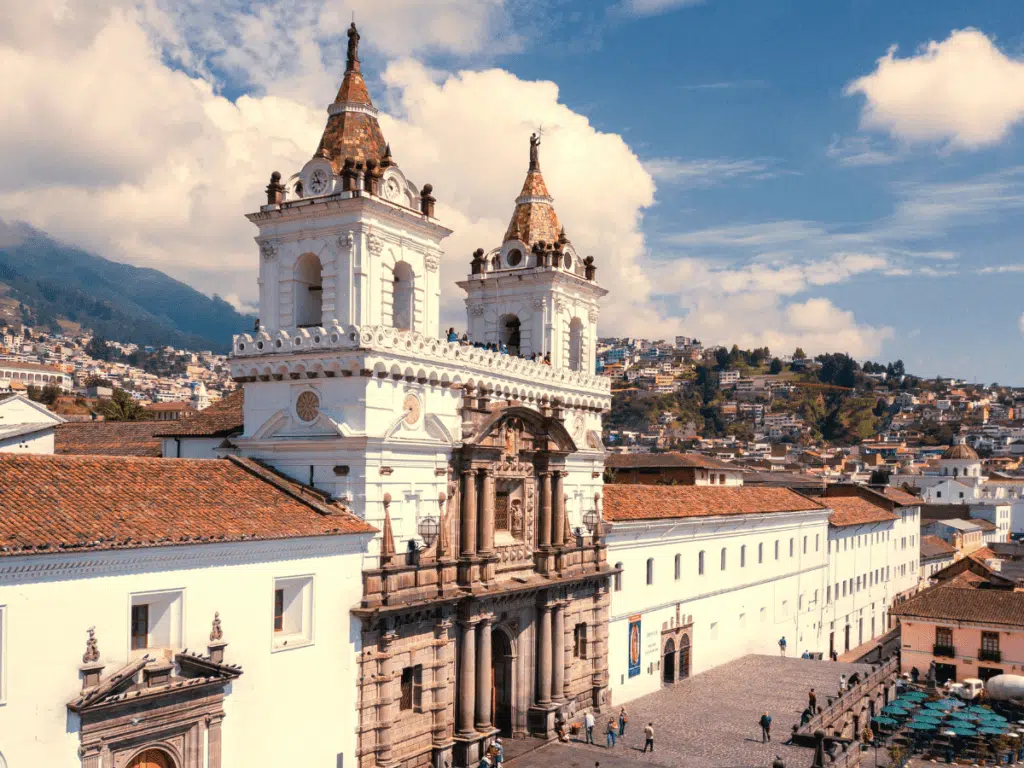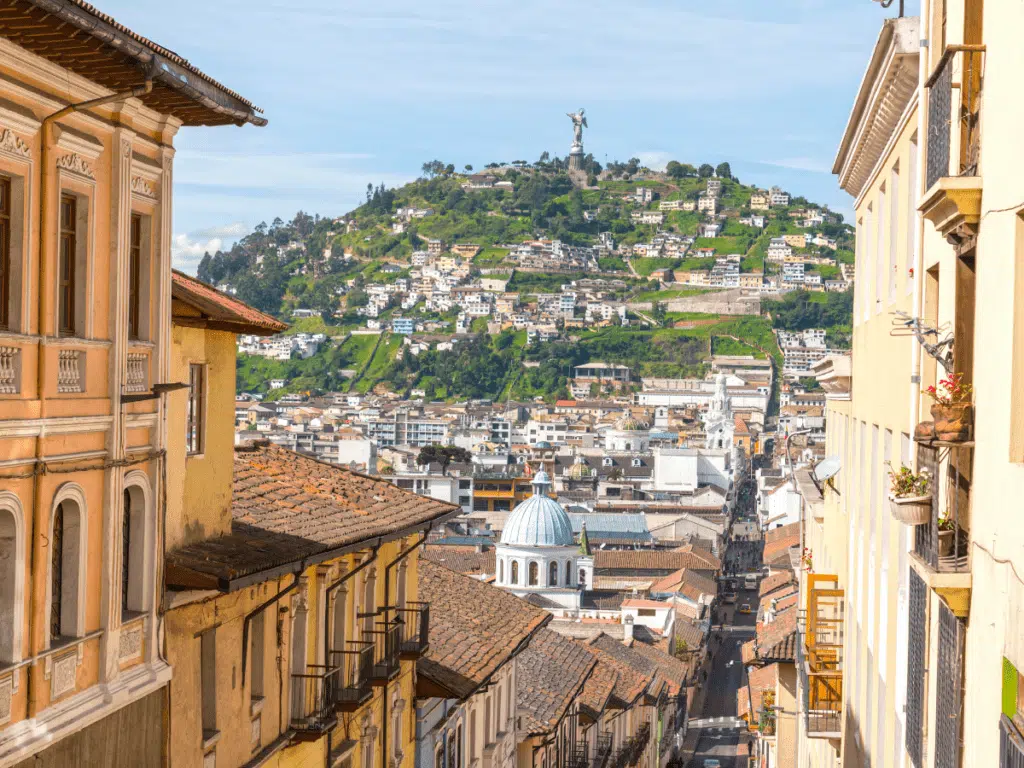Is Ecuador Safe? Ecuador Safety Guide [2023 Update]
As we cover so much about Ecuador travel on Explorers Away, we are often asked – is Ecuador safe? Unfortunately, you’ll probably hear a fair number of stories from travelers who experienced being pickpocketed or other types of instances in which they felt unsafe or were the victims of crime in Ecuador. The good news is that these stories are in the tiny minority (though these are the stories that will stick in your mind)!
In our ultimate Ecuador safety guide, we’re covering the reality of safety in Ecuador in 2023, and the basics of how to stay safe in Ecuador. We lived in Ecuador for years and didn’t have a single incident of feeling unsafe or being unsafe – here’s how we managed to stay safe in Ecuador and how you can have a perfectly uneventful trip to Ecuador you’ll love!

This post contains affiliate links that may reward me monetarily or otherwise when you use them to make qualifying purchases – at no cost to you. As an Amazon Associate, I earn from qualifying purchases. For more information, please read our disclosure policy.
Is Ecuador Safe?
Ecuador is, for the most part, quite safe. Both my personal experience living in Ecuador for years and statistics back up that Ecuador is mostly quite a safe place to live and travel.
Ecuador is actually one of the safest countries in South America when it comes to crime statistics and has relatively low levels of crime, particularly crimes that would potentially impact travelers such as theft or assault. In many areas, Ecuador is safer than even the United States!
However, with this being said, petty crimes like pickpocketing and bag theft do happen in Ecuador. While living in Ecuador for two years, I heard of several instances of travelers having their phones snatched out of their hands or taken out of their bags while they weren’t paying attention. It does happen, so it’s important to be aware of it.
While you may hear stories that make Ecuador seem unsafe, it’s important to take a measured attitude and remember that for the most part, Ecuador is quite safe! Don’t fear, but make sure to be informed before you travel.
Make sure to practice some travel safety measures to stay safe in Ecuador. Travelers often appear to be easy targets for criminals looking to swipe a wallet or a cellphone, so it’s important to make yourself look at least like a less obvious target. Thankfully, this is usually all it takes to stay safe in Ecuador.
Political Instability in Ecuador
Concerned about political instability in Ecuador? This is a valid concern, though should be a measured one, as it’s impossible to predict when moments of instability can occur.
Though Ecuador’s government is generally stable and has been quite stable since the early 2000s, there have been moments of political instability in the country, notably a series of protests by indigenous leaders and activists that all but shut down the country for a few weeks.
While Ecuador still faces some of the issues and tensions that led to those protests and subsequent though smaller ones, the government remains strong and the country stable. Incidents such as these have been quite isolated, generally only affecting those involved.
If you’re from the United States, make sure to register your trip with the State Department’s Smart Traveler Enrollment Program (STEP) to receive updates about political issues or disasters, as well as guidance and support should anything happen while you travel. Other countries have similar, free programs, which are worth looking into before your trip.
Is Ecuador Safe for American Tourists?
Ecuador is safe for American tourists, just as safe as it is for tourists from other nations. Being from the United States and living in Ecuador I never found anyone to be hostile or even rude upon learning my nationality – quite the opposite! Most Ecuadorians I met were quite fascinated to learn what had brought me to Ecuador, and exceedingly welcoming and friendly.
If you’re a traveler from the United States, there’s no need to be concerned about whether Ecuador is safe for American tourists as opposed to tourists from elsewhere.
Is Quito Safe?
Are you wondering – is Quito safe? Overall Quito is a safe city, though I again suggest you take basic travel safety measures to keep yourself and your belonging safe while navigating Quito. Pickpocketing can happen, and I’ve even heard of isolated incidents of more brazen robberies against travelers, though these are quite rare.
Stick to areas such as the Centro Historico (Old Town Quito), La Mariscal, La Floresta, and the more upscale neighborhoods around Parque La Carolina, which tend to be the areas travelers want to visit anyways!
Old Town Quito can get a bit dodgy at night, so always take a taxi here at night. It’s a best safety practice to take a taxi anywhere at night rather than walking, though this is particularly true for Old Town.
There are areas of Quito that are markedly less safe, and that I would not recommend visiting if you’re a traveler and aren’t well acquainted with and adapted to navigating in Ecuador or Latin America. Avoid the neighborhoods of San Roque (notably, the area surrounding the San Roque Market) as well as the neighborhoods south of the Panecillo.
Notably, the Panecillo is not considered safe to climb as thefts have been reported along the roadways and paths up this famous Quito monument. Take the public bus (it’s safe!) or take a taxi to the top if you want to visit the Panecillo.

Is Guayaquil Safe?
Ecuador’s biggest city and financial capital, Guayaquil is known in Ecuador as a destination that is less safe. This is true for both Ecuadorians and travelers alike. While I wouldn’t go so far as to say that Guayaquil is unsafe – whenever we visited we never felt unsafe at all – it’s important to know that Guayaquil has this reputation before you visit.
Because there isn’t as much charm and history in Guayaquil as there is elsewhere in Ecuador, most travelers end up skipping it or just passing through on their way to the beach towns along the coast or on the way to the Galapagos. There’s no need to be afraid of visiting Guayaquil, just make sure you’re informed!
Guayaquil Safety
If you’re visiting Guayaquil, stick to the central areas of downtown between the Malecón 2000 and Malecón del Salado. The historic neighborhood of Las Peñas just north of downtown also tends to be safe, but keep in mind that pickpockets are aware that tourists generally visit this area.
Feel free to walk these areas during the day, but you should definitely travel by taxi or Uber at night, no matter where you’re headed in Guayaquil.
Avoid the area of Durán, which is known to have a high crime rate. This area is quite removed from the rest of the city and there’s no real draw for travelers to visit here, so while you probably weren’t going to visit anyways, it’s certainly worth mentioning.
Travel Essential
Don’t think about traveling without a good VPN (Virtual Private Network). Using a VPN while connecting to the internet is an easy way to keep your personal information safe from hackers and trackers. We’ve used NordVPN for years and couldn’t recommend it more – it’s a must for safety online, at home or abroad.
Ecuador Safety
If you’re still wondering “is Ecuador safe?” know that the most important way to stay safe – whether you’re in Ecuador or around the corner from your own home – is by being informed and taking basic safety measures. Take your Ecuador safety seriously and I can almost guarantee you’ll have a perfectly uneventful and totally memorable trip to Ecuador.
The following are some important Ecuador safety tips that we always share with travelers. Make sure to read and practice these as much as you can while sticking to safe areas when traveling and trusting your gut instincts.
Most of all, don’t be afraid! Walk confidently, like you know exactly where you’re going and what you’re doing (even if you don’t!) – giving off an air of confidence is, in my opinion, the number one deterrent against any sort of crime!
Ecuador Safety Tips
Take a Taxi at Night… Always!
If you’re traveling through a city in Ecuador, it’s always a good idea to take a taxi (or Uber) at night rather than walking, even for just a few blocks. Even if it’s just a few blocks, you’re better off staying safe and paying a few additional dollars.
While we walked the streets of Quito at night plenty of times with no issue, it’s not something I’d recommend, especially for travelers unacquainted with the area.
Lock Your Backpack (and Suitcase)
If you’re traveling with a purse or backpack with zippers, make sure to get some s-biner micro-locks to clip your zippers together while you’re out and about. This way, no one can open your zippers without you noticing. It’s a small deterrent but an incredible effective one, just enough to keep your belongings safe.
I always lock my items in my suitcase when I leave the hotel as well, just as a matter of habit. It wouldn’t do much if someone wanted to take the entire suitcase, but it’s probably a good habit to keep when you travel.
Use a Crossbody Purse
For female travelers, I always recommend choosing a crossbody purse when traveling, ideally a sturdy one with a zipper. Crossbody purses can deter bag snatchings, as they’re not easily grabbed.
Keep Your Hand on Your Belongings
If you’re traveling through a crowded or busy area, make sure to keep your hand on your bag at all times and move your backpack to your front in areas like busy markets or in public transportation. You’ll see locals doing this as well, so definitely make sure to follow their lead.
Don’t Carry All Your Money (or Cards) At Once
It’s never wise to carry all of your cash or cards on you at one time. Just carry what you’ll need for the day – perhaps a certain amount of cash and one card, for example – and leave the rest in your hotel room. This way, in case you were to get pickpocketed, you’d still have access to money.
Read More: Where To Stay in Quito, Ecuador
Don’t Flash Expensive Jewelry or Technology
The most important part of staying safe while traveling is to make yourself appear to not be the easiest target – it’s really that simple! An important part of doing this is not drawing excessive attention to yourself by using expensive jewelry or carrying around expensive technology for everyone to see.
Don’t feel like you can’t take out your camera or smartphone to take photos – this isn’t the case at all! Just make sure that once you’re done you put these items away and zip and secure your bag; don’t wander the streets with your phone in your hand, for example.
Choose Your Seat Wisely on Public Transport
If you’re using public transport while in Ecuador (which I highly recommend as it’s incredibly affordable and can get you anywhere you want to go), make sure to choose your seat wisely. Sit further away from doors, as pickpockets can grab and bolt more easily by doors.
Also, make sure to keep your hands on your belongings and wear your backpack or purse in front of you. If you’re traveling on a regional bus, try to keep your bag on your lap if you can, or overhead across the aisle where you can keep an eye on it.
Avoid Parks at Night
After around 6 PM, avoid walking through or next to parks. Plazas are generally okay, but parks can be places where unsavory things can happen as soon as dusk arrives.
Ask For Local Advice
Locals know best! While people generally tend to assume that there is more crime or insecurity in their area than there actually is (this is something we’ve witnessed everywhere we’ve traveled), they can point out specific areas to avoid or things to be aware of near where you’re staying or traveling.
Safety Gear
We always recommend traveling with at least a few items of safety gear, whether you’re traveling in Ecuador or anywhere! These things that we always use and carry should be part of your Ecuador packing list if you’re worried about Ecuador safety, or just want to be prepared before you travel.
First Aid Kit
I always travel with a small first aid kit, no matter where I’m headed. Order an inexpensive travel first aid kit on Amazon before your trip or through some bandaids, antibacterial ointment, and painkillers in a pouch for a homemade version. These are great for blisters, scrapes, and cuts when you’re traveling.
S-Biner Micro-Locks
S-biner micro-locks are my favorite piece of travel safety gear, by far. Inexpensive and easy to use, they’re perfect for keeping zippers clipped together, a great deterrent for pickpockets. I always, always travel with these and recommend them to anyone concerned about Ecuador safety or safety wherever they travel.
Luggage Locks
I always travel with luggage locks with flexible hooks to keep luggage locked when traveling with it or when I leave it in my hotel room. These are also, of course, a must when you’re staying in a hostel.
Portable Safe
A portable safe is another great solution to keep your items safe. Lock up your passport and extra cards in your hotel room when you’re not there, or even bring it to the beach and tether it to a beach chair or tree when you’re swimming so your personal belongings aren’t at risk!
Door Stop
Travel with a small plastic or metal doorstop as a way to prevent your hotel room door from being forced open. While I don’t think this is entirely necessary for Ecuador as I’ve never heard of this happening to anyone, this is perfect for solo female travelers or anyone who just wants an added layer of security.
You can choose from a basic plastic or wooden doorstop, or a doorstop that features an alarm that is certain to scare away potential intruders.
Passport Scarf
If you’re looking for something a bit more stylish and easy-to-use than a traditional money belt (which every potential thief knows about anyways), I love these “passport scarves” and always highly recommend them. They come with a hidden pocket where you can stash your passport or money, and look like any average scarf – no one would ever know!
Personal Alarm
Many solo female travelers love to travel with a tiny personal alarm they can activate should they feel unsafe, but I recommend them for any travel. Push a button and it lets out a blaring alarm, which is usually more than enough to scare off any potential threat. These personal alarms are tiny and super convenient to pack and carry with you wherever you’re headed.
False Wallet
I know some travelers who love to carry fake wallets with them in case they’re robbed. If this were to happen, you could give the criminal the fake wallet with a few dollars and old, deactivated credit cards in it instead of your real wallet. I’ve never tried this nor needed it, but if it’s something that makes you feel safer, give it a try.
Travel Essential
Don’t head out on your adventure without comprehensive travel insurance! Good travel insurance may cover lost or stolen gear, medical emergencies, delayed or canceled flights, and more. Check out the policies available from SafetyWing or compare plans using Visitors Coverage.
Is Ecuador Safe to Travel To?
Yes – Ecuador is safe and Ecuador is safe to travel to! While it’s important to be informed and aware, don’t be talked out of visiting Ecuador because you’ve heard one too many stories from other travelers on the internet. That would be a great shame and doesn’t paint an accurate picture of Ecuador, which is one of the safer countries in South America.
Come prepared, both to stay safe and to enjoy one of the most incredible destinations in Latin America – you won’t regret it!

Carley Rojas Avila is a bilingual New York-based travel writer, editor, content marketer, and the founder of the digital travel publications Explorers Away and Home to Havana. Carley is an expert on all things Latin America, the Caribbean, and Cuba, having lived and worked in four different countries in the region. Her writing has appeared on the Associated Press wires and in Travel + Leisure, Yahoo, MSN, Euronews, The Weather Channel, and more. When she's not writing about her travels, find her front row at a Bad Bunny concert, befriending street cats, and taste-testing every pizza in Havana.
